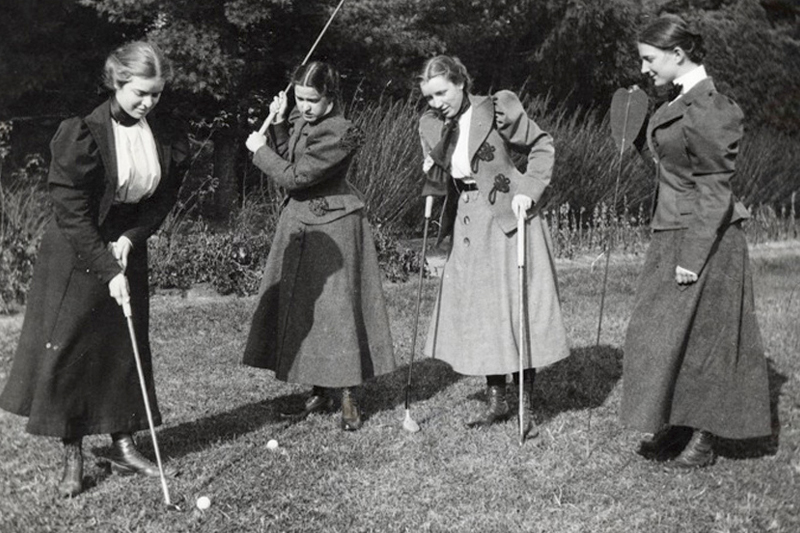I am always amazed by the style of clothing that professional golfers wear on TV, especially during tournament play. Brightly colored clothing (with stripes and plaids), new-wave painter's hats and ladies in short skirts are the norm.
Better yet, I am truly amazed at the "walking billboard look," which personally turns me off when I see a close-up of any of my favorite players on the tee or green.
It reminds me of my little league days, when the team sponsor's name was on the back of my uniform (just for the record ... I did not receive any endorsement money). The advertiser's names on the shirts and hats run the gauntlet from golf equipment to banks, to multinational company names and beyond.
So where did golf fashion start and how did we get to "walking billboards" of today? We need to begin in Scotland around 1400 AD and remember that the first skirts worn by golfers were kilts. Scottish men teed off in elaborate and colorful kilts, which allowed for "non-restrictive movement" and proper ventilation.
In the 1500s, English royalty made their debut as golfers when King James IV (no relation to LeBron) took up the game on a regular basis. The peasants caddied for the King and his court while they played in their royal attire.
Around 1725, the Scots decided to formalize the golfing look when the Royal Burgess Golfing Society of Edinburgh (say that three times real fast) required their members to wear a red jacket, white shirt, suitable pants, and a tie purchased from the Royal Society (insert first possible pro shop marketing/advertising technique here).
During the 1800s, the golf fashion world changed again. Wealthy European ladies took up the game while sporting long dresses with bustles, hats and high heeled shoes. Ladies were also "socially" restricted from swinging a club higher than shoulder height, while men played in a suit, tie, vest, hat and non-high-heeled shoes.
In 1888, the Americans (actually a Scottish immigrant named John Reid), got on board with the "new fashion trend" at his New St. Andrews Golf Club in Yonkers, New York.
The new trend turned out to be a red jacket, white shirt and New St. Andrews Golf Club tie. From the early 1900s through the '40s, golf fashion for men and women exploded out of the dark ages with such great advancements as expanding pleats in a ladies golf jacket, which in theory stopped the ripping sound from previous jackets in mid-swing.
In the 1920s, future Hall of Fame golfer Walter Hagen sends a shock wave through the golf world when he appears at a tournament wearing knickers, a sleeveless argyle sweater, a loose fitting jacket and (shock of shocks) two-tone shoes. The drab look of fashion in the 1940s, which included grey flannel slacks, a light colored shirt with a dark sweater (Ben Hogan added a white hat to this look), gave way to an explosion of color when color TV came on the scene in the early '60s.
Through the '70s and '80s, high- waisted pants with white belts and long pointed collars on solid-color shirts became the unofficial uniform of pro golfers (Johnny Miller made plaid pants with flared bottoms a popular style of his era).
Somewhere between the 1960s and today, sponsors saw an opportunity to decorate the players with advertising, because there is no rule inside the PGA declaring this practice null and void.
As golf popularity picked up steam, and with big money tournaments and superstars emerging in the game, golf wear today is a multi-billion-dollar industry, with Nike, Tommy Hilfiger and Ralph Lauren leading the way.
Not to be outdone, over the years Jack Nicklaus, Arnold Palmer, Greg Norman and Tiger Woods, to name a few, have come out with their own lines of clothing for men and women and have made a bundle of cash. (Woods' deal with Nike has paid him nearly a quarter-billion dollars since 1996.)
So next time you tee it up, try to look like a golfer and wear the latest fashion on the links.
19th Hole Trivia:
• In the 1960s, pro golfer Doug Sanders earned the nicknamed, “Peacock of the Fairways,” when he wore purple pants and turquoise sweaters. He was also named “Best Dressed Athlete of the Year” by Esquire Magazine.
• In 1969, Tony Jacklin won the British Open wearing all purple, including a turtleneck.
• Hall of Famer Gary Player ignored current fashion trends and wore all black from head to toe. He earned big bucks and was nicknamed the “Black Knight.”
• In 2012, Phil Mickelson did not have a clothing line, but did use an English tailor to help dress him and coordinate his golfing look for the pro tour.





















































